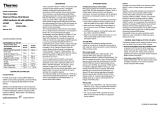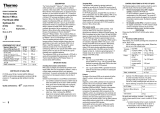Page is loading ...

PRODUCT INFORMATION
Thermo Scientific
Maxima H Minus
Reverse
Transcriptase
Pub. No. MAN0012047
Rev. Date 17 June 2016 (Rev. B.00)
Lot __ Expiry Date __
Components
#EP0751
#EP0752
#EP0753
Maxima H Minus
Reverse
Transcriptase,
200 U/µL
2000 U
10000 U
4 10000 U
5X RT Buffer
1 mL
2 1 mL
4 1 mL
*5X RT Buffer is also available separately (#B91)
Store at -20 °C
www.thermofisher.com
For Research Use Only. Not for use in diagnostic procedures.
Description
Thermo Scientific™ Maxima™ H Minus Reverse Transcriptase
(RT) is a novel RT enzyme that was developed through in vitro
evolution of M-MuLV RT. The enzyme possesses an RNA and
DNA-dependent polymerase activity but lacks RNase H activity.
The engineered enzyme features dramatically improved
thermostability, processivity and an increased synthesis rate
compared to wild type M-MuLV RT. Eliminated RNase H activity
ensures high yields of full length cDNA products up to 20 kb.
Features
Thermostable – 90% active after incubation at 50 °C for
60 min in a reaction mixture. Active up to 65 °C.
RNase H minus - high yields of cDNA up to 20 kb.
High sensitivity - reproducible cDNA synthesis from a wide
range of starting total RNA amounts (1 pg – 5 µg).
Efficient – completes cDNA synthesis in 15-30 minutes.
Increased resistance to common reaction inhibitors.
Incorporates modified nucleotides
Applications
First strand cDNA synthesis for RT-PCR and RT-qPCR.
Synthesis of full length cDNA for cloning and expression.
Generation of labeled cDNA probes for microarrays.
Analysis of RNA by primer extension.

Source
E.coli cells carrying an engineered pol gene fragment of
Moloney Murine Leukemia Virus.
Definition of Activity Unit
One unit of the enzyme incorporates 1 nmol of dTMP into a
polynucleotide fraction in 10 min at 37 °C.
Storage Buffer
The enzyme is supplied in: 50 mM Tris-HCl (pH 7.5),
0.1 M NaCl, 1 mM EDTA, 5 mM DTT,
0.1% (v/v) Triton X-100 and 50% (v/v) glycerol.
5X RT Buffer
250 mM Tris-HCl (pH 8.3 at 25 °C), 375 mM KCl,
15 mM MgCl2, 50 mM DTT.
Inhibition and Inactivation
Inhibitors: metal chelators, inorganic phosphate,
pyrophosphate and polyamines.
Inactivated by heating at 85 °C for 5 min.
CERTIFICATE OF ANALYSIS
Endodeoxyribonuclease Assay
No detectable degradation was observed after incubation of
supercoiled plasmid DNA with Maxima H Minus Reverse
Transcriptase.
Ribonuclease Assay
No detectable degradation was observed after incubation of
[3H]-RNA with Maxima H Minus Reverse Transcriptase.
Labeled Oligonucleotide (LO) Assay
No detectable degradation after incubation of single-
stranded or double-stranded radiolabeled oligonucleotides
with Maxima H Minus Reverse Transcriptase.
Functional Assay
Maxima H Minus Reverse Transcriptase was functionally
tested in 1.3 kb first strand cDNA synthesis.
Quality authorized by:
(continued on back page)

Protocol for First Strand cDNA Synthesis
The following is a general protocol for first-strand cDNA
synthesis:
Mix and briefly centrifuge all reagents after thawing, keep
on ice.
1. Add reaction components into a sterile, nuclease-free
tube on ice in the indicated order:
Template
RNA
total RNA
or
poly(A) RNA
or
specific RNA
1 pg – 5 µg
0.1 pg – 500 ng
0.01 pg - 500 ng
Primer
Oligo(dT)18 (#SO131)
or
Random Hexamer (#SO142)
or
gene-specific primer
1 µL (100 pmol)
1 µL (100 pmol)
15-20 pmol
dNTP Mix, 10 mM each (#R0191)
1 µL (0.5 mM final
concentration)
Water, nuclease-free
to 14.5 µL
2. Optional: If the RNA template is GC-rich or is known to
contain secondary structures, mix gently, centrifuge briefly
and incubate at 65 °C for 5 min. Chill on ice, briefly
centrifuge again and place on ice.
3. Add the following reaction components in the indicated
order:
5X RT Buffer
4 µL
Thermo Scientific™ RiboLock™ RNase
Inhibitor (#EO0381)
0.5 µL (20 U)
Maxima H Minus Reverse Transcriptase
50 -200*U
Total volume
20 µL
*To generate highest absolute amounts of RT reaction products (in
applications such as synthesis of labelling probes) use 200 U of enzyme per
reaction. For downstream applications, such as PCR or qPCR optimize
enzyme amounts within a range of 50 U to 200 U.
Mix gently and centrifuge briefly
4. Incubate:
– if an oligo(dT)18 primer or gene-specific primer is used,
incubate for 15-30 min at 50 °C.
– if a random hexamer primer is used, incubate for 10 min
at 25 °C followed by 30 min at 50 °C.
For transcription of GC-rich RNA, the reaction temperature
can be increased to 65 °C.
5. Terminate the reaction by heating at 85 °C
for 5 minutes.
Note
The reverse transcription reaction product can be used
directly in PCR or qPCR, or stored at -20 °C for up to one
week. For longer storage, -70 °C is recommended.
Avoid freeze/thaw cycles of the cDNA.
Use 2 µL of the cDNA reaction in 50 µL of PCR mix.

Recommendations for two-step RT-qPCR
Priming: use a mix of oligo (dT)18 and random primers
25 pmol each per 20 µL reaction.
Incubation: 10 min at 25 °C followed by 15 min at 50 °C.
Recommendations for long RT-PCR (>5 kb)
Priming: oligo (dT)18 or gene specific primer should be
used.
Enzyme amount: use 20 U of Maxima H Minus Reverse
Transcriptase per reaction. 1X RT buffer can be used to
dilute the enzyme just prior to reaction.
Incubation: 30 min at 50 °C.
LIMITED USE LABEL LICENSE: Internal Research and Development
Use Only.
The purchase of this product conveys to the buyer the limited, non-
exclusive, non-transferable right (without the right to resell, repackage, or
further sublicense) to use this product for internal research and
development purposes. No other license is granted to the buyer whether
expressly, by implication, by estoppel or otherwise. In particular, the
purchase of the product does not include or carry any right or license to
use, develop, or otherwise exploit this product commercially and no
rights are conveyed to the buyer to use the product or components of the
product for purposes including but not limited to provision of services to a
third party, generation of commercial databases or clinical diagnostics.
This product is sold pursuant to authorization from Thermo Fisher
Scientific and Thermo Fisher Scientific reserves all other rights. For
information on purchasing a license for uses other than internal research
and development purposes, please contact outli[email protected] or
Out Licensing, Life Technologies Inc., 5791 Van Allen Way, Carlsbad,
California 92008.
PRODUCT USE LIMITATION
This product is developed, designed and sold exclusively for research
purposes and in vitro use only. The product was not tested for use in
diagnostics or for drug development, nor is it suitable for administration
to humans or animals.
Please refer to www.thermofisher.com for Material Safety Data Sheet of
the product.
© 2016 Thermo Fisher Scientific, Inc. All rights reserved. All trademarks
are the property of Thermo Fisher Scientific Inc. and its subsidiaries.
/














